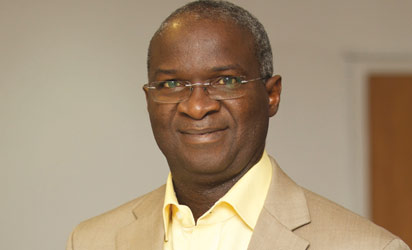
The Federal Government on Tuesday in Abuja announced that it has recovered 500 “stranded’’ containers belonging to the Transmission Company of Nigeria (TCN).
The Minster of Power, Works and Housing, Babatunde Fashola, made the announcement while receiving a 20-year Transmission Expansion Master Plan presented by the Interim Managing Director of TCN, Usman Gur Mohammed.
Fashola said the containers containing transmission equipment had been deployed to TCN sites.
He said the budgetary support from government in line with President Buhari’s mandate to the ministry to increase transmission capacity facilitated the recovery of the containers from the ports.
“The President had given a mandate to the ministry and by extension to TCN to improve its capacity to deliver service between the GENCOs and the DISCOS.
“That mandate had been followed by policy approvals, power recovery programme, the grid expansion programme.
“The N701 billion payment assurance guarantee, and also it has been supported by budgetary commitment and that budgetary support has been helpful.
“As at yesterday with that budget, we have been able to recover 500 containers belonging to TCN, containing equipment for transmission expansion projects that were left at our ports before President Buhari came.
“It is a continuous thing, now the containers had been taken to TCN sites, TCN sub-stations, where work has resumed in the north or in the south.
“Most of the TCN stations are now very busy, work stopped has started again and some projects have been completed.’’
The minister said TCN had moved from its previous wheeling capacity of 5,000 to 7,125 wheeling capacity.
“As at Dec, when we did TCN stimulated capacity, it was 7, 125, capacity and it is glowing because expansion projects have not stopped.’’
He said the implementation of the 20-year transmission expansion plan by all stakeholders would further help increase capacity of TCN.
“This is a 20-year plan, this is because in future we will no longer have stories of stranded generation and it is going to be by hard work and statement of commitment that is why everybody has a role to play.’’
He said the plan presented by TCN was a milestone to realising the incremental, steady and uninterrupted power supply target of the government.
“What you just heard is detailed, you have seen presentations about what each DISCO should do and what role they will have to play.
“You have seen how the 28 generation companies and how their present production and their expansion plan inform the basis of what will happen.’’
Fashola, who described the document as a result of rigorous thinking and projection, thanked the interim managing director of TCN for initiating the document.
He urged all stakeholders to work toward implementing the part of the plan that affects them.
Earlier, TCN’s Interim Managing Director, Mohammed told participants that the 20-year transmission plan was conceived after the delivery of the national load demand study by Tractebel in 2009.
He said the conclusion of the national load demand became necessary for Nigeria to have the least cost transmission and generation master plan.
This, according to him, is to meet the demand as explained in the load demand report.
He explained that TCN began the process by engaging the services of Fitchner in Germany under the NEGIP, a project financed by the World Bank in November 2015.
Mohammed said the study began with data collection aimed at establishing basis for the assignment.
He said the data collection process was followed by clarification by TCN system planning team in 2016.
The TCN Interim managing director said that the master plan established the basis for TCN’s rehabilitations plan supported by various donour agencies.
He explained that the final draft report by Fitchner, agreed by consultant and TCN were issued on Dec 22, 2017.
Copyright Ships & Ports Ltd. Permission to use quotations from this article is granted subject to appropriate credit given to www.shipsandports.com.ng as the source.